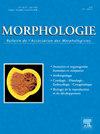在尸体解剖时偶然发现一条起源于肝动脉右支的胰十二指肠上、后动脉。
Q3 Medicine
引用次数: 0
摘要
简介:十二指肠胰区是一个高度血管化的区域。胰十二指肠上动脉和胰十二指肠后动脉是一条主要发源于胃十二指肠动脉的血管。它表现出罕见的解剖变异,例如它从肝动脉右分支出现,这是我们在尸体解剖中偶然发现的。材料和方法:这次解剖研究的尸体来自亚眠医学院解剖实验室捐赠给科学的尸体。这个解剖是一个硕士项目的一部分,目的是研究腹腔干的分支。结果:我们发现了一条胰十二指肠上动脉和一条胰十二指肠后动脉,起源于肝动脉右分支,向胃十二指肠动脉的右侧走行,并共享一条非常近端的吻合分支,该分支产生了七条短的十二指肠后动脉。这条动脉为胆管提供分支,然后沿着十二指肠和胰腺,同时向这两个相邻的器官发出大约10个小分支。与起源于肠系膜上动脉的胰十二指肠后动脉和胰十二指肠下动脉吻合。结论:了解这种解剖变异对内脏外科医生进行头侧十二指肠胰切除术、保留十二指肠框架的胰头切除术、胰头切除术合并胰空肠吻合术,甚至是处理出血性十二指肠溃疡都是至关重要的。介入放射科医师在进行胰动脉弓假性动脉瘤破裂相关的动脉栓塞时,也应了解胰十二指肠上动脉和后动脉的异常起源。本文章由计算机程序翻译,如有差异,请以英文原文为准。
Fortuitous discovery of a superior and posterior pancreaticoduodenal artery originating from the right branch of the hepatic artery during cadaver dissection
Introduction
The duodeno-pancreatic region is a highly vascularized area. The superior and posterior pancreaticoduodenal artery is a vessel primarily originating from the gastroduodenal artery. It exhibits rare anatomical variations, such as its emergence from the right branch of the hepatic artery, which we fortuitously identified during a cadaver dissection.
Materials and methods
The body studied in this dissection was from cadavers donated to science at the Anatomy Laboratory of the Faculty of Medicine in Amiens. This dissection was part of a Master's project aimed at studying the branches of the celiac trunk.
Results
We identified a superior and posterior pancreaticoduodenal artery arising from the right branch of the hepatic artery, coursing to the right of the gastroduodenal artery and sharing a very proximal anastomotic branch that gave rise to seven short retro-duodenal arteries. This artery provided branches to the bile duct and then ran along the duodenum and the pancreas while giving off about ten small branches to these two adjacent organs. It anastomosed with the posterior and inferior pancreaticoduodenal artery, which originated from the superior mesenteric artery.
Conclusion
Knowledge of this anatomical variation is fundamental for the visceral surgeon performing a cephalic duodenopancreatectomy, a resection of the pancreatic head with preservation of the duodenal framework, a resection of the pancreatic head with pancreatic-jejunostomy, or even in managing a hemorrhagic duodenal ulcer. This aberrant origin of the superior and posterior pancreaticoduodenal artery should also be known by the interventional radiologist during arterial embolizations related to the rupture of pseudoaneurysms of the pancreatic arcades.
求助全文
通过发布文献求助,成功后即可免费获取论文全文。
去求助
来源期刊

Morphologie
Medicine-Anatomy
CiteScore
2.30
自引率
0.00%
发文量
150
审稿时长
25 days
期刊介绍:
Morphologie est une revue universitaire avec une ouverture médicale qui sa adresse aux enseignants, aux étudiants, aux chercheurs et aux cliniciens en anatomie et en morphologie. Vous y trouverez les développements les plus actuels de votre spécialité, en France comme a international. Le objectif de Morphologie est d?offrir des lectures privilégiées sous forme de revues générales, d?articles originaux, de mises au point didactiques et de revues de la littérature, qui permettront notamment aux enseignants de optimiser leurs cours et aux spécialistes d?enrichir leurs connaissances.
 求助内容:
求助内容: 应助结果提醒方式:
应助结果提醒方式:


